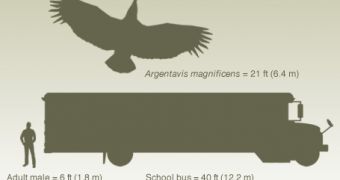This is the largest flying bird ever: Argentavis magnificens, having a wingspan up to 8.3 m (28 ft) and weighing up 100 kg (220 pounds). This bird resembles a condor and was somehow related with the condors and the ... storks! It inhabited the pampas of Argentina about five million years ago.
Now, researchers investigating how the giant bird flew, believe it was an expert glider but was too heavy to sustain an active flight, by flapping its wings. With all its massive flight muscles, Argentavis seems not to have been able to create enough lift to take off from a level surface.
"Like human hang gliders, Argentavis probably had to run downhill into a headwind to become airborne. Takeoff capability is the limiting factor for the size of flying birds, and Argentavis almost reached the upper limit. Heavier birds such as the ostrich had to give up flight," said Sankar Chatterjee of Texas Tech University in Lubbock.
The new research is a collaboration between paleontologists and a retired aeronautical engineer. The team measured Argentavis fossils and then made computer simulations comparing bird's flight performance with helicopters.
"Birds are commonly compared with aircraft, but in reality helicopters are a better analogy. Unlike engine-powered airplanes, birds rely on their wings for both forward thrust and vertical lift, the two components necessary for flight." Chatterjee said. To reach the heights of the sky, Argentavis could use riding winds deflected upward over mountains, not wing flaps. In open terrain, Argentavis probably gained elevation by employing rising columns of warm air (thermals).
"The huge flyer may have traveled hundreds of miles by repeatedly riding thermal "elevators" and then soaring gradually back to earth," Chatterjee said.
Thermals are used by some of the largest flying birds today, like eagles, vultures and Argentavis's living relatives, condors (the American vultures are in reality condor species, not real vultures, related to the eagles) and storks. These species can use active flight, but they prefer to save energy by taking advantage of the thermals.
There is a vivid debate whether Argentavis was a predator, like eagles, or a scavenger, like condors and vultures.
"[The birds' skull] was adapted for catching prey and swallowing it whole. Its jaw mechanics were not suited for tearing flesh from carcasses, as in vultures, nor for tearing prey animals apart for swallowing, as in eagles and owls." sustains co-author Kenneth Campbell, of the Natural History Museum of Los Angeles County, who believes the bird attacked rabbit-sized prey. Others believe that the huge size of the bird indicates a scavenger.
"Given its huge size, a predatory Argentavis would not have been able to cover enough ground and locate enough prey to meet its daily needs. A vulturelike behavior is more reasonable, as vultures have smaller range areas. Carrion is more available than living flesh. Given its lack of maneuverability, a predator this size would have a problem landing on its prey " said Paul Palmqvist, of the University of Malaga (Spain).

 14 DAY TRIAL //
14 DAY TRIAL //